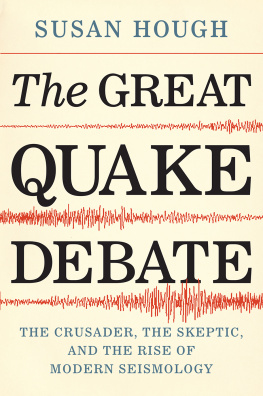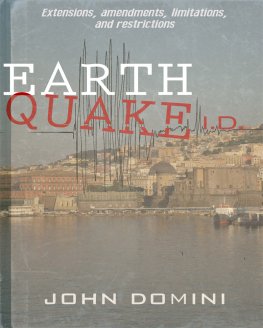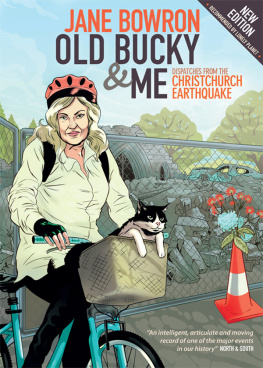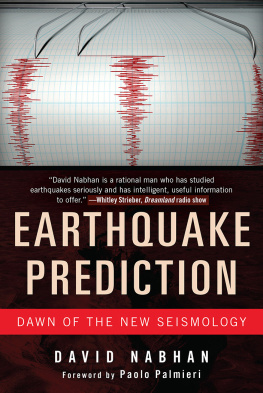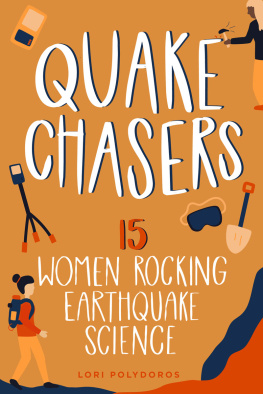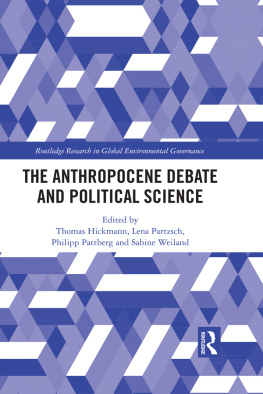THE GREAT QUAKE DEBATE
THE GREAT
QUAKE DEBATE
The Crusader, the Skeptic,
and the Rise of Modern Seismology
SUSAN HOUGH
UNIVERSITY OF WASHINGTON PRESS
Seattle
Copyright 2020 by the University of Washington Press
Design by Jarrod Taylor
Composed in Miller Text, typeface designed by Matthew Carter
24 23 22 21 205 4 3 2 1
Printed and bound in the United States of America
All rights reserved. No part of this publication may be reproduced or transmitted in any form or by any means, electronic or mechanical, including photocopy, recording, or any information storage or retrieval system, without permission in writing from the publisher.
UNIVERSITY OF WASHINGTON PRESS
uwapress.uw.edu
LIBRARY OF CONGRESS CATALOGING-IN-PUBLICATION DATA
Names: Hough, Susan Elizabeth, 1961, author.
Title: The great quake debate : the crusader, the skeptic, and the rise of modern seismology / Susan Hough.
Description: Seattle : University of Washington Press, [2020] | Includes bibliographical references and index.
Identifiers: LCCN 2019045528 (print) | LCCN 2019045529 (ebook) | ISBN 9780295747361 (hardcover) | ISBN 9780295747378 (ebook)
Subjects: LCSH: Willis, Bailey, 18571949. | Hill, Robert Thomas, 18581941. | SeismologyCalifornia, SouthernHistory20th century. | GeologistsUnited StatesBiography. | Earthquake predictionCalifornia, SouthernHistory20th century. | EarthquakesCalifornia, SouthernHistory20th century.
Classification: LCC QE535.2.U6 H682 2020 (print) | LCC QE535.2.U6 (ebook) | DDC 551.2209794/909041dc23
LC record available at https://lccn.loc.gov/2019045528
LC ebook record available at https://lccn.loc.gov/2019045529
Author photo by Gino DeGrandis, with permission of the Seismological Society of America
The paper used in this publication is acid free and meets the minimum requirements of American National Standard for Information SciencesPermanence of Paper for Printed Library Materials, ANSI z39.481984.
Los Angeles is situated a favored locality sufficiently distant from the active faults upon which great earthquakes are generated.... So far as destructive shocks are concerned Los Angeles has not acquired the habit, and if we may judge by the record, is not likely to acquire the habit.
Andrew Lawson,
February 23, 1927
CONTENTS
PREFACE
I set out to write the story of a scientific debate that played out in the early twentieth century, splashing outside of sheltered academic waters and into the news: does the Los Angeles area face significant earthquake hazard? It might be hard to imagine the answer was ever in doubt. Sometimes something is so well known that we forget that somebody figured it out in the first place. And people outside of the scientific community might not realize the extent to which the figuring-out process can be contentious. Science can be a messy business, if not a contact sport. The process by which science moves forward has as much to do with people and personalitypersuasion and push-backas with instruments or data. When science touches on matters of societal relevance, outside forces sometimes come into play. Scientists tend to view people and personality as beside the point, a distraction from the things that really matter (i.e., science). But as much as it is a science story, this book is a people story, the story of two individuals who came to embody the debate. You probably dont know their names, let alone their science, much less who they were as people. I barely knew them myself when I began this project, and in the course of spending many hours with the writings they and others left behind, I realize that much of what I thought I knew turns out to have been incomplete, if not outright wrong. May I have the pleasure of introducing Robert Thomas Hill and Bailey Willis, the costars of the great quake debate.
THE GREAT QUAKE DEBATE
PROLOGUE
Setting the Stage
Gentlemen, I want this picture to start with
an earthquake and work up to a climax.
Samuel Goldwyn
S tudies of instrumentally recorded modern earthquakes are alike; historical earthquakes are historical in their own way. Without question, the earthquake that struck California on the morning of January 9, 1857, was both portentous and historical in its own way. Hours before dawn that morning, California began to stir, initially with gentle rumblings reported at a small handful of locations including Santa Cruz and San Francisco. More people, from Santa Barbara to San Francisco, reported shaking shortly after first light that morning, and again close to sunrise. While it remains impossible to pinpoint the locations of these initial shocks with only scattered accounts of felt shaking, the distribution of reports points to a region that remains remote today, not far from the dusty stretch of State Highway 46 near the town of Cholame where James Dean met his untimely death a century later.
Modern scientists can barely characterize the early-morning foreshocks, the largest of which is estimated to have been magnitude 5.56.0. Of the earthquake that began at 8:24 a.m. on January 9, 1857its timing established by a handful of especially precise eyewitness reportswe know quite a bit more. This temblor rocked the young state of California nearly stem to stern, generating perceptible shaking that extended northward beyond Sacramento, east to Mission Las Vegas, and south beyond the Mexican border. The 1857 earthquake struck at a pivotal time in Californias history. Had this temblor occurred a hundred years earlier, it would likely not have been felt by people who kept written records. Scientists today would know about it only from the signature it left behind etched in the landscape.
But by the early nineteenth century, Catholic priests of the Franciscan order had built twenty-one missions along El Camino Real from San Diego to San Francisco, and by 1857, California had entered the Union and had started to establish itself as an American population hub. Unlike the native tribes who had lived there for thousands of years, the new settlers had a tradition of written record-keeping. By 1856, the population of the new state had reached about 500,000, including about 65,000 Native Americans. Fueled by the gold rush of 1849, by 1860 San Francisco had joined the ranks of the top twenty largest US cities, with a population of more than 50,000. Beyond the Bay Area, only a single other California city had cracked the top one hundred largest US cities as of 1860: Sacramento, with a population of almost 14,000. To the south, the city of Los Angeles existed by 1857, but the discovery of oil that propelled it to its current behemoth status was still a half century away. In the mid-nineteenth century it remained a remote outpost. Census data reveal a population of 4,385 persons in Los Angeles in 1860, just 3 percent of the state population. Other settlements had sprung up elsewhere in California, including mining towns on both sides of the Sierra Nevada and a small Army outpost at Fort Tejon, at the northern end of the corridor later known by generations of California drivers as the Grapevine.

